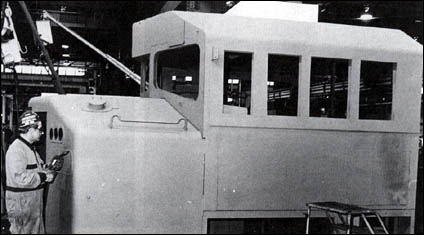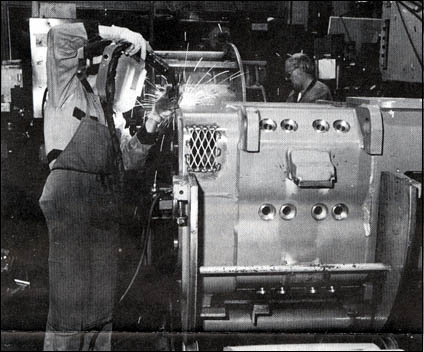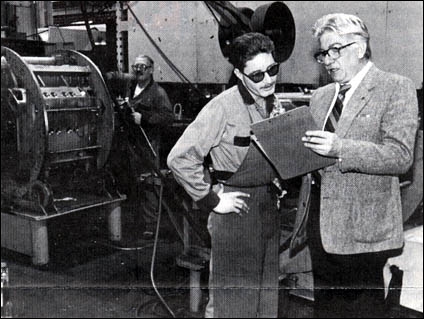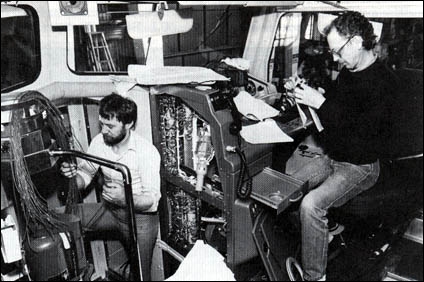Vol. 17 No. 11
November, 1987
|
Stay Safe in 87
|
|
Quality Stressed in
Locomotive Building Process
By Jim
Barlow

Taking Shape: A General
Motors employee works on the shell of a locomtive. CP Rail has purchased 1,100 locomotives from the company during
the last four decades.
London
Ontario - When they're idling, their low resonant growl makes you swear they're alive and chomping at the bit.
When they're at full throttle, they're nothing short of awe-inspiring.
They're the backbone of CP Rail's locomotive fleet - General Motors 3,000-H.P., SD40 series locomotives.
Today, more than 500 of these powerful monsters haul millions of tonnes of freight across CP Rail's system.
The new General Motors of Canada SD40F model is stronger, more fuel efficient, and comes with many of the comforts
of home.

Precision Welding: General
Motors' Thomas Fitzgerald welds a traction motor frame at the company's London, Ontario,
plant.
NEW FEATURES
There's a "hi-back" adjustable seat (armrests included), 10-kw electric heating,
front and rear window defrosters, and a few things that help melt away the hours on a long haul like a refrigerator,
hot plate, desk style console, and a forced ventilated, full-sized washroom.
The cab is larger and quieter than the old models and daily inspections can be carried out inside the warm car body
during inclement weather.
Compared to the first GM locomotive delivery in 1950, the new units have progressed from clunker to Cadillac.

On-Time
Production: Frank Doerr, general supervisor with General Motors (R), discusses production progres with
welder Thomas Fitzgerald.
PROGRESS
The first order, at the virtual dawn of dieselization, was to the Toronto, Hamilton & Buffalo Railway (now a
CP Rail division). They were four axle, 1,500-H.P. GP7 freight locomotives with 50 percent less
traction than the new SD40Fs.
In the 37 years since the TH&B took possession of the initial order GM's diesel division has delivered 1,100
locomotives to CP Rail.
The Canadian operation began constructing the 204-acre London, Ontario, plant in 1949 to meet the
conversion to diesel from steam power.
Since then, the diesel division has grown to become one of the leading North American companies specializing in
large-scale weldments and assemblies using massive production machinery.
The complex employs more than 2,000 persons with expertise in design, engineering, and production. At the heart of
their work is the diesel division's committment to quality.

Checking Circuits: Two
technicians at the General Motors plant install wiring in the cab of a locomotive being built for VIA
Rail.
DOING IT RIGHT
Quality is an element that GM not only talks about, but actually sets down as a basic requirement of each employee
at every level.
Division management recognized and was openly concerned about the rising cost of not doing the job right the first
time.
"Longer and longer lead time on new locomotives, increasing locomotive complexity, and increasing inventory
costs were all factors which led to the concern", said GM spokesman Irwin Schinkel.
This, in turn, gave birth to a new Quality Improvement Process, which began formally 19 Mar 1987, and
was based upon the four absolutes of quality:
- Quality is conformance to requirements;
- The system to achieve quality is prevention;
- The performance standard is zero defects;
- Quality performance is measured by the price of non-conformance.
Basically what we began to do was to pinpoint where things could, or did, go wrong on any given project, Mr. Schinkel
said. "Once this was established then it was not only corrected but eliminated as a future cause of
concern".
"It might be something as simple as where does CP Rail want the bell to go. If we assume one place and we're
wrong, the customer isn't satisfied", he said. "Remember, if only one percent of 3,000 components are
defective, or not designed properly, the overall result is poor quality".
TOP PRIORITY
Combatting the rising cost of quality was given top priority by the GM management team. To ensure momentum was
maintained in their drive to reach the four absolutes, a Quality Improvement Team was formed with members of the
division's executive committee.
A division Quality Policy was decided upon "...to provide products and services that conform to and satisfy
our internal and external customers' requirements. We will fully understand the requirements of our jobs and the
processes that support us. We will adhere to these requirements at all times".
TEAM APPROACH
The next step was to establish five Quality Improvement Teams zeroing in on an identified aspect of quality -
awareness, measurement, corrective action, cost, and education.
Each committee would be chaired by a member of the executive committee and the purpose was to create the environment,
changes, and system permitting the achievement of the Quality Policy.
Since the initial launch of the program, every divisional employee has been educated in the quality training process,
which ranges from five to 45 hours of instruction.
Further, a monthly "Cost of Quality" report is being distributed to each employee and all employees are
participants in corrective action and quality measurement systems.
This activity is supported by a variety of awareness activities aimed at keeping everyone thinking of quality
improvement.
"Quality improvement here", Mr. Schinkel said, "is deliberately labelled as a process, something which
has a beginning and becomes a permanent part of the divisional fabric in a never-ending manner".
The process is built around 14 steps. The fourteenth reads "return to step one and do it all over again".
The diesel division's efforts have made them an important competitor not only in Canada but around the world. In
addition to having produced more than 3,300 diesel-electric locomotives for Canadian customers more than
1,200 units have been sold to customers in 22 countries abroad with most recent being an order of 16 units for
Bangladesh.
This CP Rail News article is copyright
1987 by the Canadian Pacific Railway and is reprinted here with
their permission. All photographs, logos, and trademarks are the property of the Canadian Pacific Railway
Company.
|